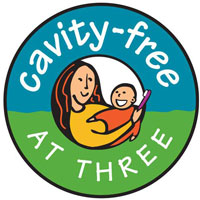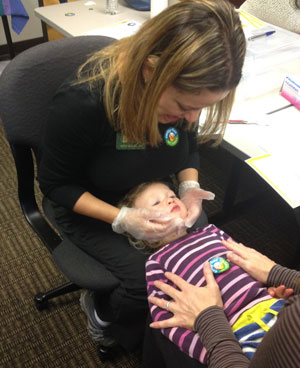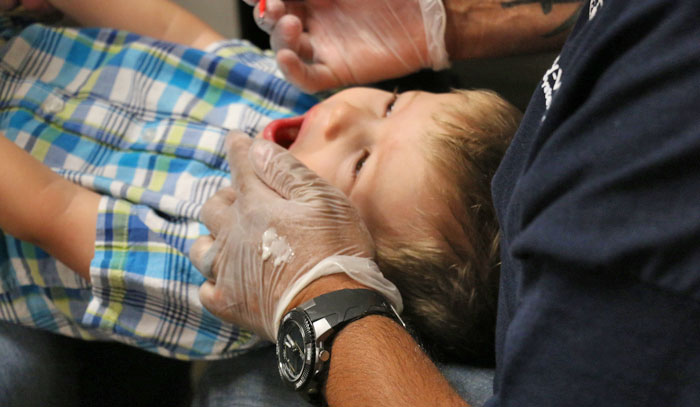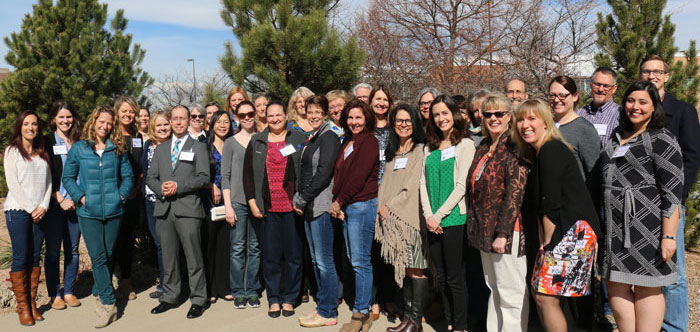Cavity Free at Three
- Need: In Colorado, 31% of children have experienced dental decay by the time they reach kindergarten. With several frontier and rural counties in Colorado considered Dental Care Health Professional Shortage Areas (HPSAs), options for oral healthcare are limited.
- Intervention: Cavity Free at Three (CF3) works to improve access to preventive oral health for pregnant women and young children.
- Results: CF3 has trained over 6,000 medical and dental professionals in performing preventive dental health. The percentage of children who received oral healthcare from a medical or dental provider before the age of 2 has progressively increased, and Colorado saw reduced cavities starting in 2007.
Description
In Colorado, 31% of children have experienced dental decay by the time they reach kindergarten. This rate increases for children in families who live in rural or frontier regions of the state, those in low wage-earning families, and those who are a racial or ethnic minority. Barriers to oral health include insurance status and cost, with uneven coverage across demographic groups. For example, Hispanic and Latino adults are significantly less likely to have dental insurance (49%) compared with white adults (67%).
For families that live in rural or frontier regions of Colorado and/or are on Health First Colorado (Colorado's Medicaid program), workforce capacity and accessibility of services may be insufficient to meet oral health demands and create significant barriers to care.
Geography, combined with a lack of providers who accept Medicaid, leaves many Coloradans without access to oral health care. In total, 50 of Colorado's 64 counties are designated as either geographic or low-income population Dental Health Professional Shortage Areas (HPSAs). For individuals who do have a reliable source of care in rural areas, it is estimated that they must travel an average distance of 64 miles for care.
 Cavity Free at Three
(CF3) is Colorado's statewide initiative to improve oral
health outcomes in pregnant people, infants, and
toddlers. CF3 tailors outreach to communities
experiencing the highest barriers to access care in order
to improve oral health outcomes, and teaches medical
professionals how to incorporate preventive oral health
services into prenatal visits and well child visits by
using the six essential services of the CF3 model and
encouraging interprofessional collaboration. The
interprofessional oral health promotion program was
established in 2007 and is led by the Colorado Department of
Public Health and Environment's (CDPHE) Oral Health
Unit.
Cavity Free at Three
(CF3) is Colorado's statewide initiative to improve oral
health outcomes in pregnant people, infants, and
toddlers. CF3 tailors outreach to communities
experiencing the highest barriers to access care in order
to improve oral health outcomes, and teaches medical
professionals how to incorporate preventive oral health
services into prenatal visits and well child visits by
using the six essential services of the CF3 model and
encouraging interprofessional collaboration. The
interprofessional oral health promotion program was
established in 2007 and is led by the Colorado Department of
Public Health and Environment's (CDPHE) Oral Health
Unit.
This video goes into more detail about the program:
Services offered
Because so many rural and frontier counties in Colorado lack dental professionals and because of the connection between oral and overall health, primary care providers in rural areas are trained to deliver oral health education, screenings, and apply fluoride varnish through CF3.
CF3 offers an approved certification program for primary care providers to deliver these services so they can get reimbursed by Medicaid.
In addition, CF3 offers free in-person or online training, resources, and support to help medical and dental professionals deliver preventive dental health services in their practices. Training creates an opportunity for providers to learn in a peer-to-peer setting. Components of CF3 training include:
- Information about preventing dental disease in pregnant patients and young children
- Key oral health messages using motivational interviewing
- Performing oral examinations
- Dental caries risk assessment
- Hands-on clinical skills training in oral health screening and fluoride varnish application
- Anticipatory guidance in how to recognize forming cavities
- Technical assistance with coding and billing preventive oral health services
- Goal setting with patients
- Dental referrals
- Continued technical assistance support after training
- Regular updates on the latest research about children's oral health
- Provider resources supporting patient education
- Medical provider certification required by Medicaid
Results
The Centers for Disease Control and Prevention (CDC) funded a screening survey of Colorado children conducted by CDPHE. Results were published in the Tooth Be Told...Colorado's Basic Screening Survey, Children's Oral Health Screenings: 2016-2017. Key results are linked to programs like CF3 and include the following:

- Fewer Colorado children have cavities now than they did 10 years ago. CF3 and other programs of the Department's Oral Health Unit have contributed to the decrease. From 2007-2017, the rate of kindergarteners diagnosed with tooth decay decreased from 45% to 31%.
- Kindergartners who have had at least one cavity has decreased 14%.
- Third graders who have had at least one cavity has decreased 10%.
CDC also funded an evaluation of CF3. Results published in the Cavity Free at Three CDC Evaluation 2013-2018 report and updated training numbers include:
- From January 2008-December 2019, 5,567 medical and dental professionals, health professional students, other health professionals, and individuals have completed a CF3 training. Health professionals who have participated in CF3 training report high satisfaction levels with the program and training.
- From 2019 to 2023, 1,499 medical professionals, oral health professionals, health professional students, and others completed CF3 training. Note that training in 2020 was impacted by COVID-19 and state restrictions.
- The percentage of children with Colorado Medicaid who received any dental service from a medical or dental provider before the age of 2 has progressively increased, from 23% in 2010 to 33% in 2017.
The effect of the Cavity Free at Three program at Denver Health Federally Qualified Health Centers was also evaluated through this study:
Braun et al. (2017). Effectiveness on Early Childhood Caries of an Oral Health Promotion Program for Medical Providers. American Journal of Public Health, 107(Suppl 1), S97-S103.
The COVID-19 pandemic introduced several barriers to families' ability to achieve optimal oral health and access services. New oral health surveillance data will be released in 2024.

Challenges
According to Colorado Health Institute's Family Matters in Oral Health report, there are certain challenges when providing oral healthcare to rural and frontier areas of Colorado. Through CF3, CDPHE has taken the following steps to address those challenges:
- Of Colorado's 64 counties, 50 are designated a Dental
Health Professional Shortage Area by the U.S. Health
Resources & Services Administration.
- The largest audience to receive CF3 trainings since the trainings launched in 2008 were health professional students.
- High-risk populations include children covered by Medicaid. While the number of dental providers who treated Medicaid patients grew by 78% from 2013 to 2016, children on Medicaid are less likely to see a dentist than those with commercial or private insurance.
- Many areas of Colorado are geographically isolated by
mountains or distance, prohibiting access to training
opportunities.
- Through a HRSA Workforce Grant, CDPHE Oral Health Unit contracts with four local public health agencies in rural communities to prioritize oral health. These agencies have each hired a dental hygienist who serves as a Regional Oral Health Specialist (ROHS). ROHS are required to become certified CF3 Master Trainers and deliver CF3 trainings to medical clinics in their area.
- Medical providers reported inadequate time to provide
oral health services during well child visits.
- CF3 created a guide on ways to efficiently and effectively implement oral health services into clinical practices. The guide includes how to develop process charts for optimizing clinic flow and allocate time for oral health services. The training also provides hand-on skill building to improve clinician competency.

Replication
Cavity Free at Three's website outlines ways to implement a similar program. These include:
- Creating buy-in by assessing your community's needs and involving a multidisciplinary group of stakeholders
- Making yourself known to the professional community
- Seeking multiple sources of funding
- Showing providers the monetary value of providing oral health services
CF3 provides a variety of free tools for clinics trained in Colorado, including:
- Free training for Colorado medical and dental professionals
- Resources provided by CF3:
- Start-up kits including fluoride varnish and printed resources
- Dental Caries risk assessment
- Goal setting sheets (in English and Spanish)
- Instructional videos on incorporating oral health into primary care
- Infant oral care kit ordering information
- Patient education pamphlets in 9 languages on oral health for pregnant patients and young children are available free for downloading, printing, and distributing
- Many more resources and tools relating to children's oral health
Topics
Access
Benefit enrollment and application
Children and youth
Medicaid
Oral health
Wellness, health promotion, and disease prevention
States served
Colorado
Date added
June 8, 2010
Date updated or reviewed
October 2, 2023
Suggested citation: Rural Health Information Hub, 2023. Cavity Free at Three [online]. Rural Health Information Hub. Available at: https://www.ruralhealthinfo.org/project-examples/647 [Accessed 24 April 2024]
Please contact the models and innovations contact directly for the most complete and current information about this program. Summaries of models and innovations are provided by RHIhub for your convenience. The programs described are not endorsed by RHIhub or by the Federal Office of Rural Health Policy. Each rural community should consider whether a particular project or approach is a good match for their community’s needs and capacity. While it is sometimes possible to adapt program components to match your resources, keep in mind that changes to the program design may impact results.
